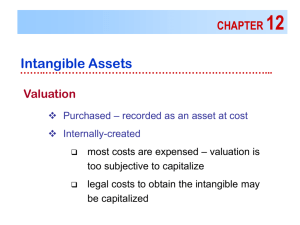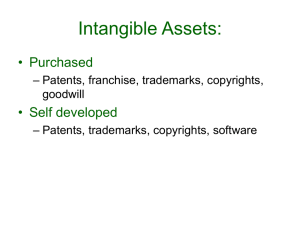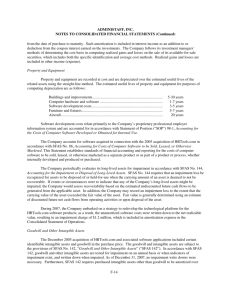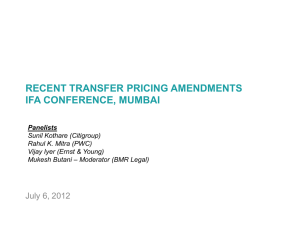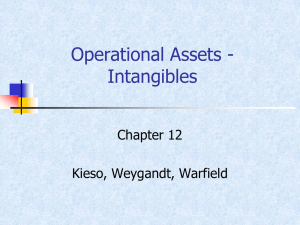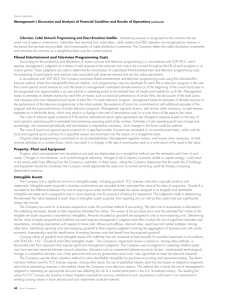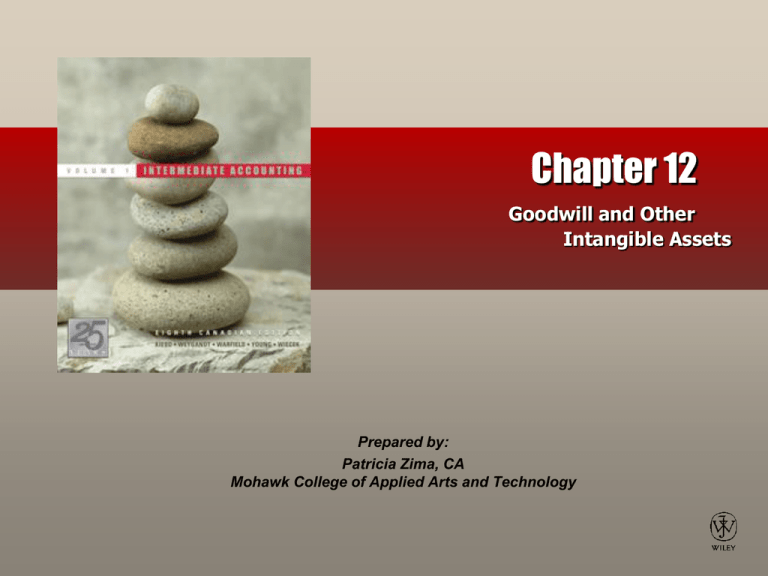
Chapter 12
Goodwill and Other
Intangible Assets
Prepared by:
Patricia Zima, CA
Mohawk College of Applied Arts and Technology
Goodwill and
Other Intangible Assets
Definition,
Recognition
and
Measurement
•Characteristics
•Recognition
and
measurement
at acquisition
•Measurement
after acquisition
Types of
Impairment
Intangibles of Intangible
•Marketing- Assets
related
•Limited-life
•Customer- intangibles
related
•Indefinitelife
•Artisticintangibles
related
other than
•Contractgoodwill
based
•Goodwill
•Technologybased
•Goodwill
Other Internally
Developed
Intangibles
•Research and
development
costs
•Development
stage costs
•Organization
costs
•Advertising
costs
•Conceptual
questions
Presentation,
Analysis, and
International
Comparison
•Presentation
of intangible
assets
•Perspectives
•Comparison
of Canadian
and
International
GAAP
Appendix
12A–
Valuing
Goodwill
•Excessearnings
approach
•Totalearnings
approach
•Other
methods of
valuation
2
Intangibles: Characteristics
•
CICA Handbook, Section 3062, broadly
defines intangible assets as:
1. Assets that are lacking in physical
substance, and
2. Assets that are not financial instruments
• Examples of intangible assets: patents,
copyrights, franchises, and trademarks
3
Recognition and Measurement at
Acquisition
• Purchased Intangibles
– Measured at cost
– Cost includes all expenditures that are necessary
to get the intangible asset ready for its intended
use (e.g., purchase price, legal fees)
• If intangible assets are exchanged for non-monetary
assets, the fair value of the item given up or the fair
value of the intangible received is used to determine
cost
• For a “basket purchase” of intangibles, the cost is
allocated based on fair values
4
Recognition and Measurement
at Acquisition
•
Identifiable intangibles:
– are recognized separately
– must have at least one of the following
characteristics:
1. Results from contractual or legal rights,
2. They can be separated from the entity and
sold, rented, exchanged, transferred or
licensed
• Identifiable intangibles with similar
characteristics should be grouped and reported
5
together
Recognition and Measurement
at Acquisition
• Internally Developed Intangibles
– Costs that a company incurs internally to
create intangibles (such as patents and
brand names) are generally expensed
• Deferred Charges
– Costs incurred that benefit future periods
– It has become less acceptable to recognize
deferred charges unless the costs meet the
definition and recognition requirements of
Section 1000
6
Accounting for the Acquisition Costs
of Intangibles
Type
Manner Acquired
Purchased
Internally
created
Identifiable
Capitalize
Generally
expense
Goodwill-type
Capitalize
Expense
Other internally
developed
Capitalize restricted amounts
for both
7
Measurement after Acquisition
•
An intangible asset with finite (or limited) useful
life is amortized over its useful life
• Intangibles assumed to have no residual value,
unless:
1. There is a commitment to purchase, or
2. There is an observable market
• An intangible asset with an indefinite useful life
is not amortized and an impairment test is
carried out at least annually
8
Valuation after Acquisition
•
•
Factors to consider when determining useful life of
an intangible asset:
1. Expected future usage
2. Legal, regulatory, or contractual provisions
that may limit useful life
3. Effects of technological or commercial
obsolescence
4. Level of maintenance expenditures required
to obtain future benefits
Method of amortization chosen should match
benefits received, otherwise, straight-line
amortization used
9
Types of Intangibles
Six major categories for intangibles:
1. Marketing-related
2. Customer-related
3. Artistic-related
4. Contract-based
5. Technology-based
6. Goodwill
10
Marketing-Related Intangibles
• Used in marketing and promotion
• Include:
– Trademarks or trade names
– Newspaper mastheads
– Internet domain names
– Non-competition agreements
11
Trademarks and
Trade Names
• Trademarks and trade names are renewable
indefinitely every 15 years, so the legal life may be
unlimited; the useful life, however, may be limited
• Costs of acquired trademarks or trade names are
capitalized
• If trademarks or trade names are developed by the
business, all direct costs are capitalized
• If the future benefits of a trademark (such as CocaCola) is determined to have an indefinite life, it is
not amortized
12
Customer-Related Intangibles
• Result from interactions with third parties
• Include:
– Customer lists
– Order/production backlogs
– Contractual and noncontractual customer
relationships
13
Artistic-Related Intangibles
• Ownership rights to artistic endeavours
• Examples: literary works, musical works,
pictures, photographs and audiovisual
material
• These ownership rights are protected by
copyrights
14
Copyrights
• Copyrights are granted for the life of the creator,
plus 50 years
• Copyrights can be sold or assigned, but cannot be
renewed
• Useful life is generally less than the legal life
• Amortized over period in which benefits accrue
• Costs of acquiring and defending copyrights are
capitalized
• Research costs associated with a copyright are
expensed
15
Contract-Based Intangibles
• Value of a right resulting from a contractual
arrangement
• Examples: licensing arrangement, leaseholds,
construction permits, broadcast rights, service or
supply contracts, franchises, and licenses
• A franchise is a contractual agreement where
franchisor grants the franchisee the rights to:
– sell specified products or services
– use certain trademarks or trade names
– perform certain functions within a particular
geographical area
16
Franchises and Licenses
• A franchise may exist for a limited time or for an
indefinite time period
• The cost of a franchise (with a limited life) is
amortized over the lesser of the legal or useful life
• A franchise (with an unlimited life) is amortized
over:
– expected useful life if such life is deemed
limited, or
– it is not amortized
• Annual operating payments for a franchise are
expensed
17
Leaseholds
• Agreement between the lessor (owner) and the
lessee (renter)
• Gives the lessee the right to use the property
• Valid for a specific period of time
• The lessee makes stipulated, periodic cash
payments which are normally expensed
• Capital Leases: if the lease agreement transfers
all benefits and risks to the lessee
• For capital leases, the PV of all future payments
is recorded as a tangible asset and as a longterm liability
18
Leaseholds and Leasehold
Improvements
• Lease prepayments are reported as prepaid
expenses, not as intangible assets
• Leasehold improvements are improvements
made by the lessee to the leased property
• These leasehold improvements revert to the
lessor at the end of lease term
• They are generally shown in the property,
plant, and equipment section of the balance
sheet, rather than with intangible assets
19
Technology-Based Intangibles
•
Relate to innovations or technological
advances
• Include:
1. Product Patents
• Physical (tangible) products
2. Process Patents
• Process by which products are made
3. Computer Software Costs
20
Patents
• A patent gives exclusive right to the holder for
making, selling or using a product or process
• Costs of purchasing patents are capitalized
• Costs to research and most development costs
are expensed as incurred
• Patents are amortized over the shorter of the
legal life (20 years) or their useful lives
• Legal fees and other costs to successfully
defend a patent are capitalized and amortized
over the remaining useful life of the patent
21
Computer Software Costs
• External Use
– Designed for resale
– Development costs treated as research and
development costs
• Internal Use
– Designed for use within the organization
– Purchase cost and all direct costs of the
software may be capitalized
– Any modifications to the software are capitalized
if considered a betterment
22
Goodwill
• Goodwill is the excess of the purchase price
over the fair value of the identifiable tangible and
intangible net assets acquired in a business
combination
• Goodwill can be acquired and sold only when a
business combination occurs
• Goodwill cannot be separated from the business
• Internally-generated goodwill is not capitalized
• Goodwill is the only intangible requiring separate
disclosure on the balance sheet
23
Acquired Goodwill: Valuation
Given:
Purchase price (cash):
Book value of assets:
Book value of liabilities:
Fair value of assets:
$ 400,000
$ 255,000
$ 55,000
$ 350,000
To determine goodwill, see the following:
24
Acquired Goodwill: Calculation
Goodwill =
Purchase price – Fair value of identifiable net
assets
Goodwill = $400,000 less 350,000 = $50,000
Entry in the books of the Purchaser:
Assets (various) 405,000
Goodwill
50,000
Liabilities
55,000
Cash
400,000
25
Negative Goodwill
•
“Negative goodwill” or a bargain purchase
arises when fair value of acquired net assets
is greater than the purchase price
• The current standard requires that:
– The excess is used to reduce the amounts
assigned to other acquired assets that are
generally non-financial in nature, and
– Any excess remaining is treated as an
extraordinary gain
26
Goodwill–Valuation after Acquisition
•
Three approaches have been suggested:
1. Charge immediately to expense
– Results in consistent accounting for purchased
goodwill and internally generated goodwill
– One rationale is that difficult to identify the
useful life
2. Amortize over useful life
– Better matching of costs to benefits
3. Carry at cost indefinitely, unless value impaired
– Method approved by Accounting Standards
Board
– Management is responsible for performing an
impairment test
27
Intangible Asset Impairment –
Limited-Life Intangibles
• Impairment occurs when carrying value of an
asset is greater than fair value of the asset
• A recoverability test is necessary to determine
whether the asset has been impaired
• If expected future cash flows is less than the
carrying amount of the asset, asset is impaired
• If impairment, an impairment loss (carrying
amount – fair value) is recognized in the period,
usually as part of continuing operations
• Same approach as for impairment of tangible
assets
28
Limited-Life Intangibles
Impairment
Example:
Carry amount of patent
$6,000,000
Recoverable amount
3,500,000
Fair value (discounted amount) 2,000,000
Recoverability test?
• Indicates impairment
(since $3,500,00 < $6,000,000)
Impairment loss?
• $6,000,000 – $2,000,000 = $4,000,000
29
Limited-Life Intangibles
Impairment
Loss on Impairment
4,000,000
Accumulated Amortization, Patents 4,000,000
• Remaining carrying amount amortized over
expected useful life
• Future increases in value of intangible are not
recognized
30
Indefinite-Life Intangibles Other
than Goodwill - Impairment
• Impairment test should be done annually
• Use fair value test only
• Fair value of intangible compared to the
carrying amount
• When fair value is less than carrying amount,
impairment has occurred and loss is recorded
• The recoverability test is not used for
indefinite-life intangible assets
31
Goodwill Impairment
•
Two-step process
1. Fair value of the reporting unit compared
to carrying amount of the reporting unit,
including goodwill
• When fair value greater than carrying
amount, no impairment
• When fair value less than carrying
amount, then a second step is
required
2. Determine if goodwill is impaired (see
next slide)
32
Goodwill Impairment
•
•
•
•
Compare implied current fair value of goodwill
with carrying amount of goodwill
Implied current fair value of goodwill:
– Fair value of the whole reporting unit is
compared to the fair value of the identifiable
net assets
When the fair value is less than carrying amount,
impairment is recognized
Goodwill impairment loss is reported separately
in the income statement before extraordinary
items and discontinued operations
33
Deferred Charges
• Intangibles that may be recorded as deferred
charges include: deferred development costs,
pre-operating and start-up costs, and
organization costs
• CICA Handbook, Section 3070, Deferred
Charges, removed from the handbook in
2005
• “Deferred charges” are not as common as
previously, as the costs must now meet the
definition of an asset
34
Research and Development
(R&D) Costs
•
R&D costs are not in themselves intangible
assets
• Generally material in amount and generally
lead to something that will be patented or
copyrighted
• Challenges in R&D accounting:
1. Determining costs associated with a
particular activity or project
2. Determining size of future benefits and for
how long those benefits may be realized
35
Research and Development
(R&D) Costs
• CICA Handbook, Section 3450 governs the
accounting for R&D costs:
– All research costs are charged to expense
when incurred
– Development costs are charged to expense
except in certain defined circumstances
– An exception to the above, may be able to
capitalize if a company purchases in-process
R&D as part of a business combination
36
Research and Development
(R&D) Costs
• Research activities:
– involve planned search or critical investigation
aimed at discovery of new knowledge
– may or may not be directed towards a specific
project
• Development activities include:
– translation of research findings or other
knowledge into a plan or design for a new
product or process, or
– significant improvement to an existing product
or process
37
Research and Development
(R&D) Costs
•
•
R&D costs include the following:
1. Materials and services consumed
2. Direct personnel costs (e.g., salaries)
3. Amortization of equipment and facilities used
in R&D activities
4. Amortization of intangibles related to R&D
activities
5. Reasonable overhead allocation
Development costs are capitalized when all five of
the following conditions are met and future benefits
are reasonably certain
38
Research and Development
(R&D) Costs
•
Development cost capitalization criteria:
1. Product/process clearly defined, and costs
can be identified
2. Technical feasibility has been established
3. Management’s intent is to produce and
market or use the product/process
4. If the intent is to sell, a market is clearly
defined; if the intent is to use, there is a
definable use/need
5. Resources exist to complete the project
39
Pre-Operating Costs
•
•
•
Costs incurred prior to start of formal
operations
EIC-27 allows for the deferral of pre-operating
costs if three conditions are met:
1. The expenditure relates directly to placing
the new business in service
2. It would not have been incurred if not for
the new business
3. The amount is likely to be recovered from
future operations of the new business
Amortized over maximum of 5 years
40
Other Deferred Charges
Organization Costs:
• Costs incurred to form a corporation (e.g.,
underwriter fees, legal fees)
• Usually recorded as an intangible asset
• They are usually amortized over a relatively
short period of time (perhaps up to 5 years)
Advertising Costs:
• No Canadian standard
• Usually expensed as difficult to measure future
benefits
41
International Comparison
• Canadian and international GAAP are
substantially converged for intangible
assets
• Some differences still exist related to the
treatment of “negative” goodwill, preoperating costs, internally developed
intangibles, and impairment models of
goodwill and other intangibles
42
COPYRIGHT
Copyright © 2007 John Wiley & Sons Canada, Ltd.
All rights reserved. Reproduction or translation of
this work beyond that permitted by Access Copyright
(The Canadian Copyright Licensing Agency) is
unlawful. Requests for further information should be
addressed to the Permissions Department, John
Wiley & Sons Canada, Ltd. The purchaser may make
back-up copies for his or her own use only and not
for distribution or resale. The author and the
publisher assume no responsibility for errors,
omissions, or damages caused by the use of these
programs or from the use of the information
contained herein.
43

